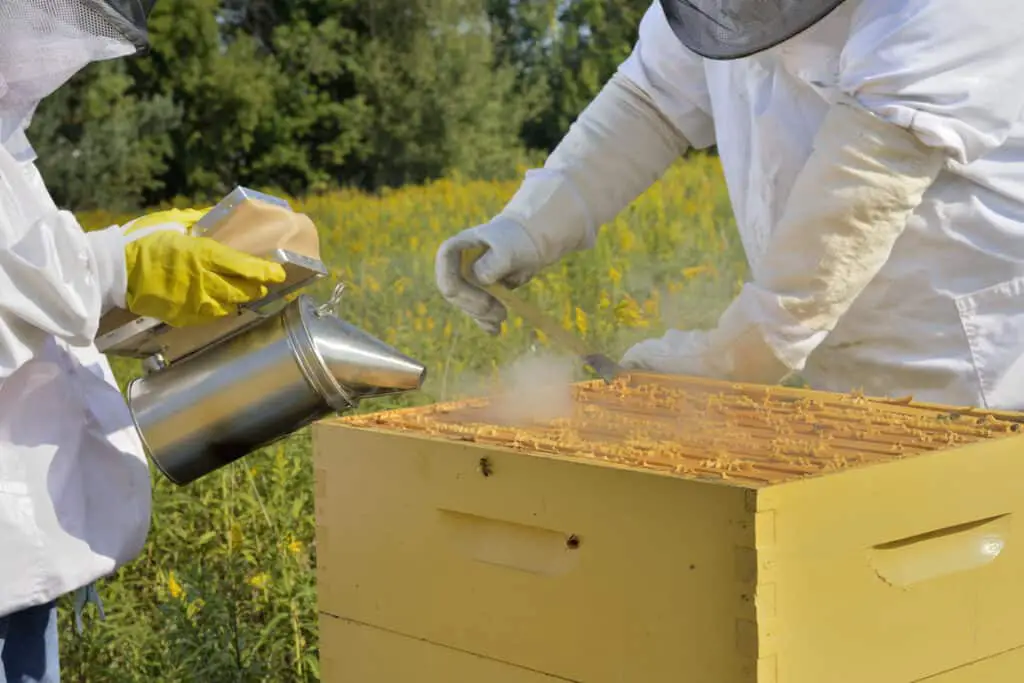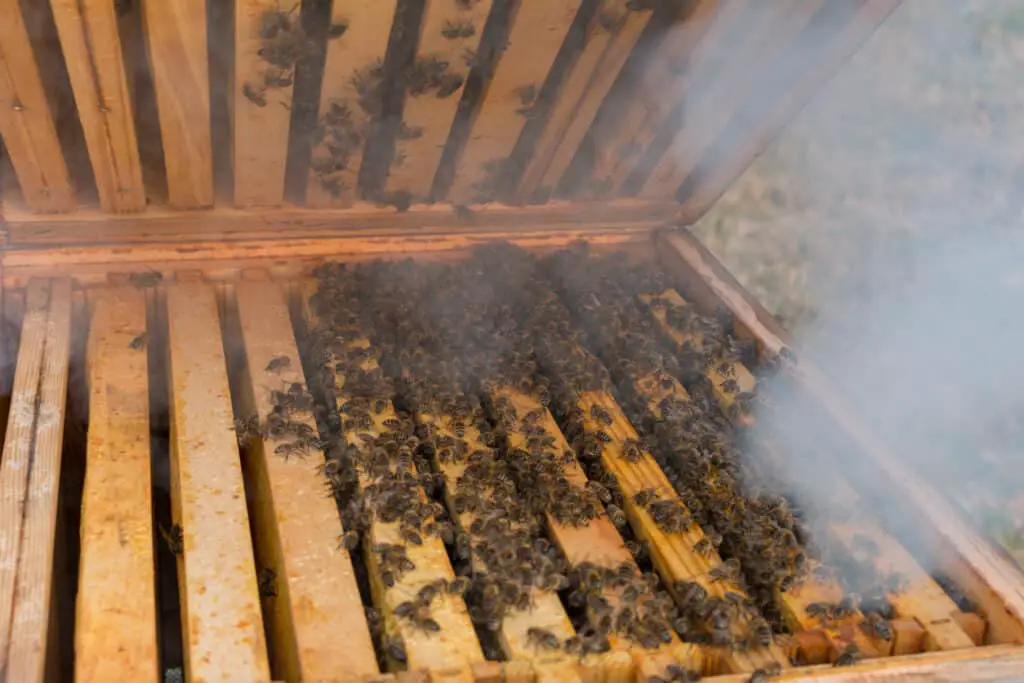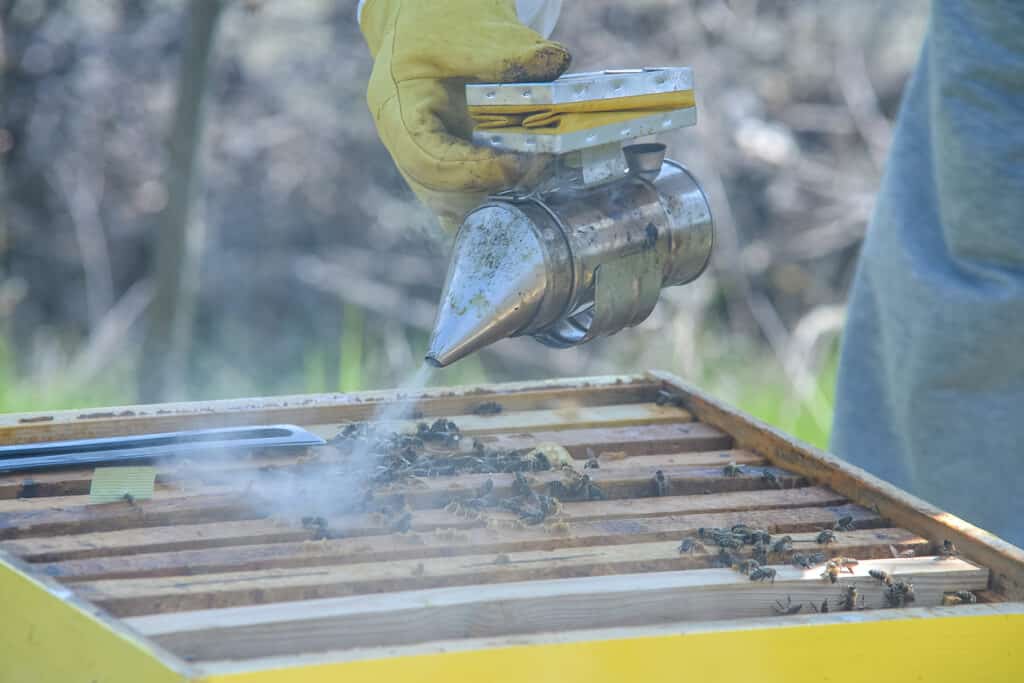When beekeepers do their daily job of retrieving honey, they are always cautious and with good reason. Getting stung by not one but hundreds of bees is not the ideal outcome any person would want. However, as a beginner or professional beekeeper, ensuring the bees are calm makes the job easier.
Bee smokers are used to calming the bees because the moment they sense danger, they release a pheromone called isopentyl acetate. As a result, beekeepers will avoid any possibility of getting stung. While inspecting bee hives, the first and most important thing is to use smoke.

Any job with a possible injury can easily be avoided or controlled. Owning the title of a beekeeper and knowing what you are doing is essential. Is it just smoke that calms bees, or can you use different ways instead?
Why Do Beekeepers Smoke Hives Before Inspection?

When beekeepers harvest honey, the main procedure that is generally always used is to smoke bees. Ever wonder why they do that? Aside from protecting themselves from getting stung, the smoke helps to keep the bees calm without causing any harm.
The moment bees feel threatened, they will immediately try to defend themselves, so using smoke will provide some time for a beekeeper to harvest. However, this method creates interference with a bee’s line of communication.
In self-defense, bees will generally release isopentyl acetate, a pheromone that resides in a gland near their stingers. Bees communicate mainly with their sense of smell, so they are alarmed when other bees pick up on a specific scent.
The pheromone that a bee release smells similar to that of banana oil. The same scent is released when a bee stings you, allowing a bee colony to be alarmed; therefore, multiple stings are possible. Avoiding this from happening for a beekeeper is essential.
When beekeepers smoke a colony, the bee’s first reaction is survival, which is why they try to collect as much honey as possible when they smell smoke. The intention is to make them think the hive is on fire and a new one is a priority.
The more honey they collect, the less likely they can sting because causing their death interferes with transporting the bee honey to the bee’s new home. The disruption of the smoke is only temporary and will not cause any harm to the bees.
How To Make Use Of A Bee Smoker

A hole in the bottom of the traditional smoker gets made of a metal can. A cone-shaped covering protects the connecting bellows. Modern beekeepers continue to employ this technique. Therefore, it’s critical to understand how a smoker’s internal combustion functions.
For conventional smoking, you must first light a fire. The smoker should then be filled with a variety of fuels, including pet bedding, woody biomass, or sawdust. When the bee smoker is loaded with your fuel mix, you may use a long grill lighter to ignite a fire.
Keep in mind that an open flame inside the smoker might lead you to damage the bellows if you overfill the container. As a result, the bees’ wings are more likely to be melted away by the open flame leaching out from the front.
Snuffing out the open flame and piling extra fuel con the smoldering biomass can help prevent flames from scorching the bees. Next, you’ll put the smoker’s cover on once you’ve checked the temperature.
Guidelines To Smoking A Hive
Following the correct steps effectively to smoke a hive is easy. This method should only take a few minutes, so doing it correctly the first time is essential. Keep in mind not to harm any bees while doing so. All lives matter, even if they are as small as a bee’s.
Reduce the risk of being stung by approaching the hive in small, controlled steps and keeping any movement to a minimum. Approaching the bee hive slowly is critical.
When inspecting the hive while temperatures are about 70 °F, for example, in the mornings or the afternoons, it makes the whole process much more manageable. These bees are presumably out on a quest for pollen.
Beekeepers should approach the hive from the sides or the back to avoid getting stung by stray bees. Next, smoke the hive entrance using two or three puffs to clear away the remaining bees.
Knowing and understanding how these method works helps you, as a beginner or professional beekeeper, to stay safe. When puffing on a hive, remember that too much may be harmful.
Can Too Much Smoke Harm Bees?
Using too much smoke on bees can cause the bees to become aggressive or confused. When puffing too much smoke into the hive confuses the bees. In addition, they evacuate and move towards the grass, protecting the queen from possible injury.
How Does Smoke Affect A Honey Bee?
Smoke masks a bee’s sense of smell and prevents them from sending out alarm signals which they do when they feel they are in danger. The moment they get fooled into thinking there is a forest fire, they get drunk on honey, which calms them down.
To protect their most valuable treasure, which is honey, a small class of worker bees provides a bodyguarding duty to the colony. When approaching the hive, these bees will alarm the other bees and sacrifice their own lives to protect the bee hive.
This is the reason why beekeepers use a bee incense device designed to produce smoke that pacifies the bees in two ways. It either impedes their sense of smell, or they go into survival mode when thinking their home is under attack.
Making Your Own Bee Smoker Fuel
Using organic materials is the way to go when deciding to spice things up and produce your smoker fuel that is pleasant to smell. Follow these few easy steps and create a sweet aroma that even the bees will enjoy.
Step 1 – Gathering Organic Materials
Look around your home for any material you can burn instead of throwing out, such as mint, lavender, basil, or sage. Remember to set aside anything in the sunflower family to dry and then put it in the smoker.
Step 2 – Organizing The Materials
Inform yourself of the dominant characteristics of the materials that you gathered. This information helps to know how they will burn, for example, dry pine needles or eucalyptus leaves. These two materials are trendy because they burn for a long time.
Step 3 – Start The Drying Process
Typically, herbs like lavender or oregano are dried in bundles by hanging from a string indoors or in an arid environment. This drying method may take a few weeks, but when the stems in the middle crack or snap, they are dry enough and ready to go.
Even stringing dry citrus peels on hemp twine-like bead using a large-eye blunt needle can work. This drying procedure can also take up to a few weeks to dry. When bending the citrus peel and it snaps, it is dry enough and ready for burning.
Place them on cookie sheets using delicate materials such as flower petals or basil leaves. Place the sheets in the oven and turn the heat very low for about 10 to 15 minutes daily. Like any baking project, do not leave the materials unsupervised in the oven.
Step 4 – Start Making Your Blends
Do not be afraid to blend different types of materials. It can be as simple as two ingredients, or combining more is the answer if you choose a more complex blend. Remember to test the materials in your smoker before using them on the bees.
Step 5 – Fold And Make Your Packets
Old brown paper bags can help hold your fuel blends. Keep in mind that as long as the inks are soy-based, it is alright if the paper bag has some printing. Your packet is ready to go with a few folds and some scissors.
Step 6 – Start The Burning Process
Using two packets per beehive inspection is recommended. Therefore, the next step is to place the packets directly into the chamber of the smoker. Then, light the paper with a match at the bottom. Remember, it takes a few squeezes of the bellows to create a flame.
How Often Does A Beekeeper Need To Smoke Bees?
Beekeepers are like smokers; they use it differently and don’t inhale it themselves. Most traditional beekeepers have their smokers on hand and use them daily. Some might even say that you are not a beekeeper if you do not use smoke.
It is interesting to know that some beekeepers that mainly do it as a hobby never tend to use smoke. Other alternatives, such as sugar water spray, are generally used. Smoking your beehive as often as you wish can not harm the bees. The right amount of smoke in each attempt is the key.
Is Smoke Always Necessary When Working With Bees?
Honey bees are not always eager to break clusters during the winter season. A Beekeeper can easily slide extra sugar patties into the feeder and close the hive immediately without a single bee emerging. So no smoke is even needed.
It is easy to add more honey supers if needed during honey flows. The reason is that honey bees are single-minded in their nectar flow, and minor disturbances are not likely to receive reactions from them. So once again, no smoke is needed when slight adjustments are made.
Doing quick checkups without a smoker while the weather starts warming up is essential. In addition, during this period, a bee colony is generally more docile, making the working environment for a beekeeper a lot more stress-free.
The Difference Between A Bee Smoker And Sugar Water Spray
Whether deciding as a beekeeper to take the general approach and use a smoker, there will always be a few that like changing it up. Beekeepers who like to try something different use sugar syrup instead of smoke.
Cultures worldwide for thousands of years have been using smoke to harvest honey from either feral or domestic honey bee colonies. Unfortunately, pheromones released by all bees are always masked by the smoke used by bee smokers.
These pheromones being their lifeline and ability to communicate with each other, get hindered by the smoke. Therefore, it makes the bees more passive and able to tolerate any beekeeper approaching their hive.
By smoking a bee hive, the beekeeper can conduct proper inspections, check on the queen, and, most importantly, harvest sweet honey. Honeybees tend to move away from smoke, allowing the beekeeper to manipulate each colony member.
Sugar syrup consists of a concoction with a ratio of 1:1 of water to sugar. The sugar syrup or sugar water is placed in a spray bottle. In contrast, beekeepers generally puff some smoke at the hive’s entrance. Spraying sugar syrup directly onto the bees separates the two methods from each other.
Opening the hive to spray the sugar syrup onto the bees already gives the beekeeper a disadvantage and makes it more possible for injury. The sugar syrup coats the bees, and while they furiously try to clean themselves, the beekeeper is then able to perform an inspection.
Remember that sugar-coated bees are not always easily manipulated, so when closing the hive, it is still possible to crush them; therefore, it is essential to be careful. In addition, not every single bee will get coated when using sugar water spray, leaving some prone to strike.
Interesting Facts To Consider When Using Smokers
The satisfaction of each beekeeper can quickly be impacted when considering the smoker size and fuel used. It is also easier to light a giant smoker, and they tend to burn for longer. Remember that the fuel type can also determine how long the smoker stays lit.
It can also be interesting to note that a beekeeper can choose to smoke their hands when they do not wear gloves. By doing this, any scent usually gets masked as well as other odors from bees or even your sweat.
When smoking the frame ends, the bees move away, allowing the beekeeper to pick up the frame. It is important to remember that only a puff or two is needed to control and calm the bees. Too much smoke will make the bees agitated.
The smoker size should match the number of colonies you will work on. When choosing a proper smoker, you can easily spend around $35 to $45. A Decent 4-inch diameter by a 7-inch-tall smoker can be used on five to ten colonies before adding more fuel.
Protective Clothing And Gear For A Beekeeper
Remember that bees react to woolly or dark materials; therefore, wearing light and smooth clothing is the correct choice. Also, always ensure that the protective clothing is holeless because the moment a bee observes the smallest hole, it will not hesitate to grab the opportunity to sting.
You can purchase ventilated helmets from beekeeping supply stores. A Ventilated helmet keeps your head nice and cool during hot summer days and supports the bee veil. Avoid dark hats, as they can still cause bees to react.
A Firm hat fitted with a folding wire veil will allow the hat to hold its shape and separate the face from the bees outside the veil. Beekeeping suits are essential and are fitted with elastic cuffs and wrist bands. This clothing piece is also critical for protection.
Gloves are essential and must be strong but pliable to allow any movement from the hands or fingers. Elastic-sided boots are the most common footwear for beekeepers because they cover the ankles. Wearing sock protectors for additional protection is also an option.
Conclusion
Knowing how to work with bees is always essential, whether a beginner or a professional beekeeper. Smoking a hive to conduct an inspection and just harvesting that sweet honey is crucial because the smoke calms the bees.
Beekeepers mainly use smokers to create an illusion of fire; therefore, when the bees sense danger, they immediately try and stock up on as much honey as possible. However, in using smoke, the bee’s sense of smell is interrupted, and their main focus is not on you but on saving their precious treasure.
References
https://www.sciencefocus.com/nature/how-does-smoke-subdue-bees/
https://www.hobbyfarms.com/why-do-beekeepers-smoke-their-hives-2/
https://www.scienceabc.com/nature/how-does-smoke-affect-honey-bees.html
https://entomologytoday.org/2018/09/10/why-smoking-soothes-the-stressed-out-bee-hive/

